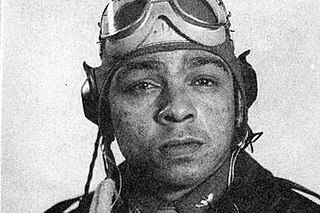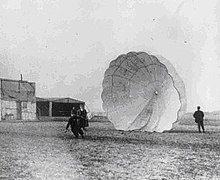
A parachute is a device used to slow the motion of an object through an atmosphere by creating drag or, in a ram-air parachute, aerodynamic lift. A major application is to support people, for recreation or as a safety device for aviators, who can exit from an aircraft at height and descend safely to earth.

Coatesville is a city in Chester County, Pennsylvania, United States. The population was 13,350 at the 2020 census. Coatesville is approximately 39 miles west of Philadelphia. It developed along the Philadelphia and Lancaster Turnpike beginning in the late 18th century. It spans U.S. Route 30, the "Main Line" highway that runs west of Philadelphia.

This is a list of aviation-related events from 1912:

Antony Habersack Jannus, more familiarly known as Tony Jannus, was an early American pilot whose aerial exploits were widely publicized in aviation's pre-World War I period. He flew the first airplane from which a parachute jump was made, in 1912. Jannus was also the first airline pilot, having pioneered the inaugural flight of the St. Petersburg–Tampa Airboat Line on January 1, 1914, the first scheduled commercial airline flight in the world using heavier-than-air aircraft. The Tony Jannus Award, created to perpetuate his legacy, recognizes outstanding individual achievement in the scheduled commercial aviation industry and is conferred annually by the Tony Jannus Distinguished Aviation Society founded in Tampa, Florida, in 1963.

Polly Berry was an African American woman notable for winning two freedom suits in St. Louis, one for herself, which she won in 1843, and one for her daughter Lucy, which she won in 1844. Having acquired the surnames of her slaveholders, she was also known as Polly Crockett and Polly Wash, the latter of which was the name used in her freedom suit.

Thomas Scott Baldwin was a pioneer balloonist and U.S. Army major during World War I. He was the first American to descend from a balloon by parachute.

Hugh Armstrong Robinson was a pioneer in the earliest days of aviation, combining his skills of inventor, pilot, and daredevil. Among other things, he is said to have been the third person to successfully fly an aircraft after the Wright Brothers in an aircraft of his own design and construction, and the first person to make an air-sea rescue. His many firsts also include the first medical flight transporting a doctor to patient in Hammond, N.Y. in June 1912, and the first U.S. airmail flight in 1911. Robinson also devised the term and art of dive-bombing.
The Coal and Iron Police (C&I) was a private police force in the US state of Pennsylvania that existed between 1865 and 1931. It was established by the Pennsylvania General Assembly but employed and paid for by the various coal companies. The Coal and Iron Police worked alongside the Pennsylvania National Guard, and later the Pennsylvania State Police, beginning in 1877. The remaining Coal and Iron Police commissions were allowed to expire in 1931, ostensibly ending the state-sanctioned organization of a private police force. Industrial policing continued in limited form until the later 1930s, when the National Labor Relations Act, the Fair Labor Standards Act and other federal legislation made armed industrial force illegal.
Grant Morton (1857?–1920), born William H. Morton, was one of the first people to successfully attempt skydiving, and is sometimes credited with the first skydive and jump from a powered aeroplane, in 1911. Supposedly, at age 54, Morton, a veteran career parachutist, made the first dive by jumping from a Wright Model B over Venice, California.

Thomas W. Benoist was an American aviator and aircraft manufacturer. In an aviation career of only ten years, he formed the world's first aircraft parts distribution company, established one of the leading early American aircraft manufacturing companies and a successful flying school, and from January to April 1914 operated the world's first scheduled airline.

The Benoist Land Tractor Type XII was one of the first enclosed cockpit, tractor configuration aircraft built. Benoist used "Model XII" to several aircraft that shared the same basic engine and wing design, but differed in fuselage and control surfaces.

The lynching of Francis McIntosh was the killing of a free Black man, a boatman, by a white mob after he was arrested in St. Louis, Missouri, on April 28, 1836. He had fatally stabbed one policeman and injured a second.
Raymond Arthur Byrd was an African-American farmhand who was lynched by a mob in Wythe County, Virginia on August 15, 1926.

Mary Dunlop Maclean was a writer and journalist and the first managing editor of The Crisis from 1909 until her death.

The 1919 Coatesville call to arms was when the black community of Coatesville, Pennsylvania formed a large armed group to prevent a rumoured lynching. Only later when the armed group had surrounded the jail to prevent the lynching did they learn that there was no suspect and no white lynch mob.

The lynching of Jay Lynch, age 28, took place in Lamar, Missouri, on May 28, 1919. That year had 83 lynchings in the United States. This was one of four against white men.

Walter P. Manning (POW) † was an American fighter pilot of the primarily African American Tuskegee Airmen. He flew 50 missions, and was awarded the Air Medal for heroism six times. After being shot down in 1945, he was captured in Austria and subsequently lynched by a mob. He was posthumously awarded the Congressional Gold Medal in 2007 along with all other Tuskegee Airmen. Manning is the only known black man to have been lynched in Austria during World War II.

The lynching of Zachariah Walker occurred on August 13, 1911, in Coatesville, Pennsylvania. A white mob attacked and burned African American steelworker Zachariah Walker alive in retaliation for reportedly killing Edgar Rice, a white Worth Brothers Steel company police officer.















